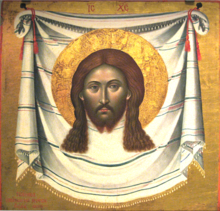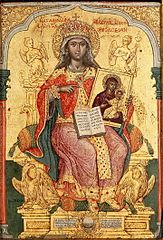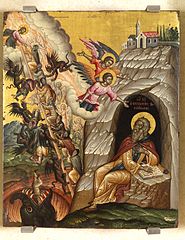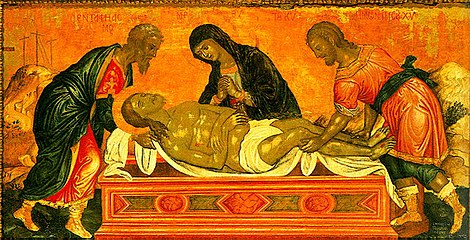Emmanuel Tzanes
Emmanuel Tzanes | |
|---|---|
 The Holy Towel | |
| Born | 1610 Rethymno Crete |
| Died | March 28, 1690 Venice |
| Nationality | Greek |
| Movement | Cretan School, Heptanese School |
Emmanuel Tzanes (Greek: Εμμανουήλ Τζάνες, 1610 – 28 March 1690), also known as Bounialis (Greek: Μπουνιαλής) Emmanuel Tzane-Bounialis, Emmanuel Zane, and Emmanuel Tzane. He was a Greek Renaissance painter. He was an author, clergyman, painter, and educator. He was the parish priest of the church of San Giorgio dei Greci. An important Greek church in Venice. He was affiliated with the Flanginian School of the Greek Confraternity in Venice. He was a prominent painter. His known works number over 130 pieces. His works can be found in public foundations, private collections, churches and monasteries in Greece. He collaborated with many artists namely Philotheos Skoufos. Both artists were members of the Cretan School. He was influenced by the Venetian school. Emmanuel's brothers were famous painter Konstantinos Tzanes and poet . His most popular work is The Holy Towel finished in 1659.[1][2][3][4][5]
History[]
Tzanes was born in Rethymno, Crete. He became a priest sometime before 1637. He fled Crete around 1646 because Rethymno was conquered by the Ottomans. He first traveled to Corfu. He remained there for eight years. He painted numerous icons and collaborated with Philotheos Skoufos. In early 1655, he traveled to Venice where he remained for the rest of his life. In March of 1655, he submitted an application to become the priest of San Giorgio dei Greci and offered to paint the church for free. His application was denied. Philotheos Skoufos was the priest at the church. Eventually, in 1660 Tzanes was elected the parish priest of the Greek Orthodox Church San Giorgio dei Greci. He replaced Philotheos Skoufos. Tzanes served for 20 years. He married 26 people between 1660-1689.[6] He was also the supervisor at the Flanginian School of the Greek Confraternity in Venice.[7]
Emmanuel's career spanned over 60 years. His one hundred thirty works are dated from 1636 to 1689. His paintings differed in size shape and style ranging from small icons, triptychs, to monumental paintings and sanctuary doors. He followed the rules and styles of the Cretan School which he studied in Rethymno. His clients were both Catholic and Greek Orthodox. He frequently included his patrons in his icons and also dated his works. He frequently painted Saint Alypios the Stylite, Saint Govdelaas the Persian, and Saint Demetrios on Horseback. He also painted many icons of the Virgin and Christ enthroned. His icon of Saint Spyridon is of Monumental size. His brother Konstantinos Tzanes was an active painter and lived in Venice with him. [8][9]
Gallery[]

Portrait of Jesus

Virgin and Child

Virgin and Child

Lamentation

St.George killing the dragon

St.Mark the Evangelist

Nicholas

Christ enthroned

Theodora
Saint Cyrille

Ladder of Divine Ascent

Miracle of Cincture

John Baptist

Lamentation of Christ
Timeline of Artistic Works[]
Crete[]
- 1636 Saint Spyridon (Correr Museum, Venice)
- 1640 Evangelism (Berlin State Museums)
- 1641 Theotokos Amolintos (Madonna and Child) (Museum of Zakynthos)
- 1644 The Tree of Jesse (Hellenic Institute of Venice)
- 1645 Theotokos Odigitria (Madonna and Child) (Holy Trinity Giudecca, Venice)
- 1645 Agios Antonios (Panagia ton Xenon, Corfu)
- 1646 Timios Prodromos (John the Baptist) (Church of Timios Prodromos, Kranidi)
Corfu[]
- 1648 Christ in Glory (Metropolitan Palace, Corfu)
- 1648 Saint Cyril (Byzantine and Christian Museum, Athens)
- 1649 Agios Iason (Church of Saints Jason and Sosipatros, Corfu)
- 1650 Agios Sosipater (Church of Saints Jason and Sosipatros, Corfu)
- 1650 Theotokos Enthroned (Church of Saints Jason and Sosipatros, Corfu)
- 1651 Theotokos (Virgin) Madre della Consolazione (Monastery of Platytera, Corfu)
- 1654 Saint Cyril of Alexandria (Museum of Antivouniotissa)
- 1654 Agios (Saint) Ioannis o Damaskinos (Church of Saints Jason and Sosipatros, Corfu)
- 1654 Saint Gregory of Palamas (Church of Saints Jason and Sosipatros, Corfu)
- 1655 Agios (Saint) Gavdelaas (Private Collection, Venice)
- 1656 Agios (Saint) Dimitrios (Loverdos Collection)
- 1657 Do not touch me (Antivouniotissa, Corfu)
- 1657 The Virgin Mary Madre della Consolazionne
- 1657 Saint Mark (Benaki Museum)
Literary Works[]
- Satisfaction is beneficial for every Christian (In Greek)
- Sequence of the holy great martyr Fotini of Samaritan, or Christ spoke in the well (In Greek)
- Narration with lyrics of the terrible war that took place on the island of Crete (In Greek)
See also[]
References[]
- ^ Speake, Graham (2021). Emmanuel Tzanes Encyclopedia of Greece and the Hellenic Tradition. London And New York: Rutledge Taylor & Francis Group. p. 443.
- ^ Heinz Skrobucha, The World of Icons, 1971, p.97
- ^ Jane Turner, The Dictionary of Art, 1996, p.334
- ^ Steven Bigham, Heroes of the Icon: People, Places, Events, 2000, p.136
- ^ Tsokkoy, Κ. Α. (2008). Aristotle University of Thessaloniki Philosophical School Refugees of the Cretan War (PDF). Thessaloniki, Greece: Aristotle University of Thessaloniki. pp. 87–88.
- ^ Tsokkoy, 2008, p. 158
- ^ Speake, 2021, p. 443-447
- ^ Eugenia Drakopoulou (May 25, 2021). "' Tzanes (Zane) Konstantinos (Constantino)". Institute for Neohellenic Research. Retrieved May 25, 2021.
- ^ Speake, 2021, p. 444-445
- 1610 births
- 1690 deaths
- Cretan Renaissance painters
- Greek Renaissance humanists
- 17th-century Greek people
- Italian people of Greek descent
- People from Rethymno
- 17th-century Greek painters
- Artist authors
- Greek artist stubs
- European painter stubs










